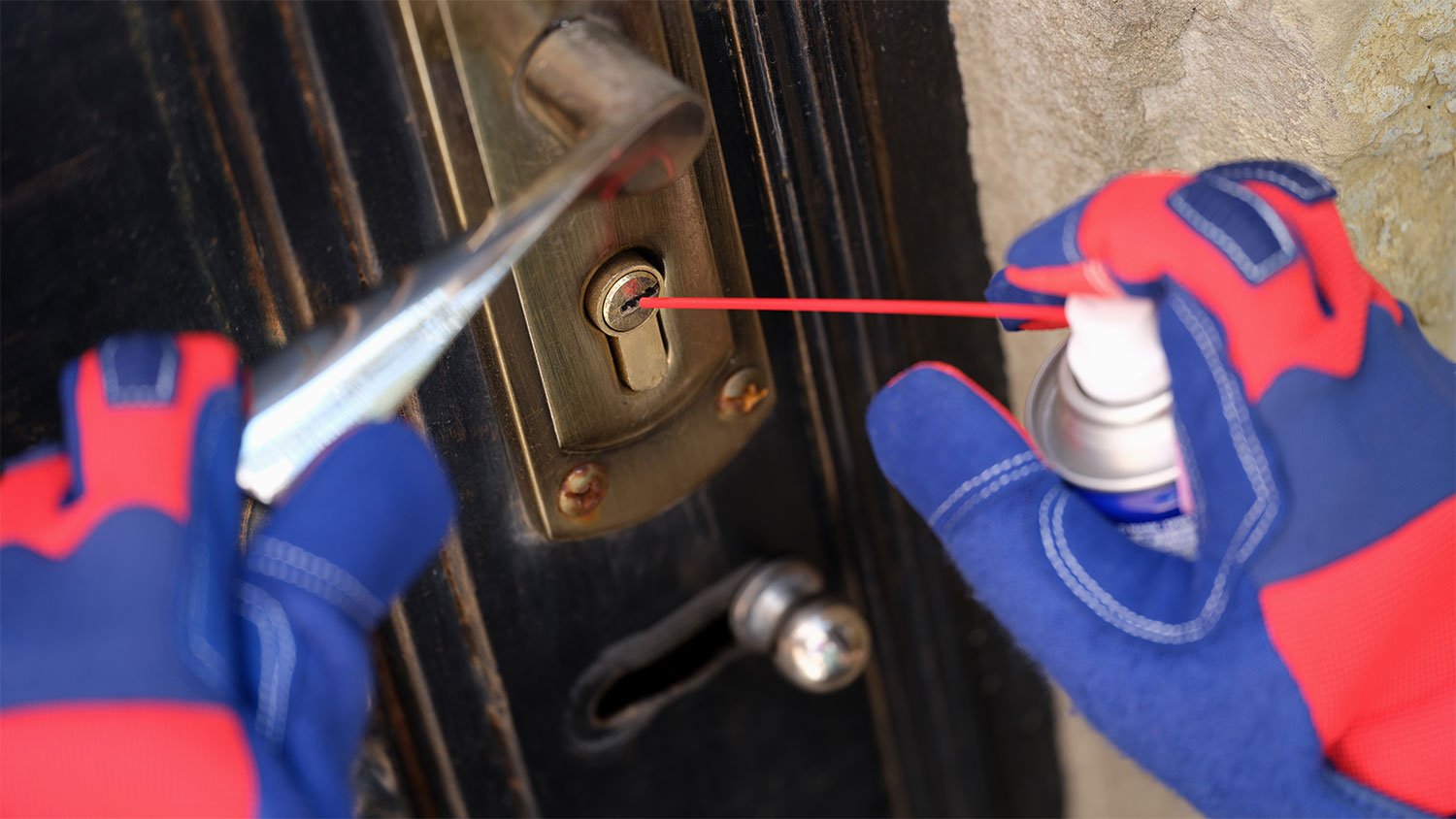How to Lubricate a Lock: 10 Ways to Unstick a Lock
The key is the product you use


Do you have a key that won’t turn in a lock? Maybe your key won’t even go in the lock, or maybe you have to use excessive force to turn it. Before you accidentally break the key inside your lock, try one of these easy lubrication options to fix your problem.
1. Teflon Dry Lubricant
Teflon-based dry lubricant is preferred by some locksmiths over other options, like graphite or WD-40. It’s ideal because, besides lubricating your lock, it repels water and dust. That means that once you fix a lock with this type of lubricant, you can expect the lock to be in good shape for a long time.
2. Teflon Aerosol Lubricant
In addition to the dry version, you can get Teflon-based lubricant in aerosol form. You might find that this option is easier to apply. When you spray this into your lock, this product creates a thin coating inside the lock. The coating repels dirt, dust, and chemicals. It has no silicone and is a long-lasting solution.
3. Powdered Dry Graphite
Powdered graphite comes in small tubes. You can easily squeeze the product into the lock. After that, take your key and distribute the graphite—place the key in and out of the lock, and then turn the key to the right and left.
Dry graphite can work well, but if you live in a humid area, the moisture can turn the powder into a gunky substance. In these cases, using a Teflon or silicone-based lubricant might be better.
4. Graphited Lock Fluid
Graphite lubricant is also available in graphited fluid form. You apply the oil, and the carrier solvent evaporates while leaving a graphited film inside the lock. It helps repel moisture, so it’ll keep your locks from freezing. The film is also stable in extremely high temperatures. It’ll also keep rust away, and it has zero volatile organic compounds (VOCs).
5. Pencil
If you don’t want to buy a bottle of powdered graphite, you can use a run-of-the-mill pencil instead. It’s best to start with a sharpened pencil. Rub the point along the edge of your keys until it’s covered in a coat of graphite. Next, place the key in the lock. Repeat as many times as necessary until the key slides easily into the lock.
It’s not an ideal solution for the long term, but if you don’t have time to run to the store to buy products, this is a decent temporary workaround.
6. WD-40 Specialist Lubricant

Although it might be tempting to reach for your regular can of WD-40 to lubricate your lock, it’s probably better if you don’t. Unfortunately, regular WD-40 attracts dust and dirt and dries up over time. This means that it won’t be long before your lock starts freezing up and not working correctly. Plus, the product can leave a greasy residue on your keys, which can easily transfer onto your clothing or bags.
Instead, opt for WD-40 Specialist lubricant. This repels dust and dirt, and you can safely use it on nearly all types of door locks.
7. De-Icer and Lubricant
Consider de-icer and lubricant combos if you live in an extremely cold area. It’s great if your car or house lock is iced over because it’ll de-ice and lube it at the same time. Usually, these are pressurized aerosol products, so all you have to do is spray it directly into the lock. Typically, using the de-icer and lubricant once should be enough to keep your locks from freezing again for some time.
8. Non-Toxic Mineral-Based Lubricant
If you’re sensitive to chemical products, consider a non-toxic, mineral-based lubricant. These repel dirt and dust and also have rust inhibitors to help your locks last longer. They can also prevent your locks from freezing.
9. Synthetic Oil with Syncolon (PTFE)
Synthetic lubrication oils with tiny Syncolon (PTFE) powder are another option for your stubborn locks. The solvent in the oil carries the dry powder. So once you apply it to your lock, the solvent dries quickly, leaving the powder behind. The layer of PTFE offers the lubrication you need for your locks, and it doesn’t attract dust.
10. Proprietary Lubricant
Some companies produce lock lubricants with a proprietary blend. Although they keep the contents a secret, it’s known to be a “proprietary blend of base oils and solvents.” It seems to be a powerful solution, especially for super old and rusted locks.
DIY vs. Hiring a Pro
If you’re having difficulty fixing your lock even after applying lubricant or simply can’t delay getting into your locked space, call a locksmith near you to get professional help. They’ll be able to assess and fix the solution quickly without you having to run to the hardware store or potentially make the problem worse.
The average locksmith visit costs $100 to $240, but it’s well worth the price tag for peace of mind about your home’s safety. And if you’re tired of dealing with the disadvantages of a traditional key and lock, consider the advantages and vulnerabilities of electronic locks.
Frequently Asked Questions
If you’re having an issue turning the key inside a lock, chances are there is dust or dirt buildup within the cylinder. The easiest solution is applying a dry lubricant to the lock, which loosens the dirt buildup. You may need to turn the key a few times for it to work properly again.
It’s best to avoid using oil-based lubricants within a lock because they attract larger amounts of dust and debris. When this occurs, it can make it harder for you to operate the lock, or it can even cause damage to the internal locking mechanism. A dry lubricant is the ideal solution instead.
Yes, you can use Vaseline instead of WD-40 if you need a quick substitute. However, keep in mind Vaseline may not work for all applications, including inside locks. While it can work great on door hinges, it may be too sticky for locks and end up attracting dust and dirt particles—which can cause damage to your lock.





- 9 Ways to Fix a Key That’s Not Turning in a Lock
- How to Get a Stuck Key Out of a Lock, Even in a Panic
- How to Get a Broken Key Out of a Lock (With Tools You Already Have)
- 8 Door Lock Maintenance Tips to Keep Your Home Secure
- 5 Common Signs Your Locks Have Been Tampered With and What to Do About It
- How to Pick a Lock (And When It's Time to Call a Locksmith)
- Which Is Better: Rekeying vs. Changing Locks?
- How to Secure a Door Without a Lock While You Wait for a Locksmith
- The 12 Most Common Types of Door Locks
- Should You Change the Locks on a New House?










